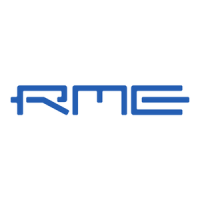10. Technical Background
10.1 DS - Double Speed
When activating the Double Speed mode the ADC Module operates at double sample rate. The
internal clock 44.1 kHz turns to 88.2 kHz, 48 kHz to 96 kHz. The internal resolution is still 24
bit.
Sample rates above 48 kHz were not always taken for granted, and are still not widely used
because of the CD format (44.1 kHz) dominating everything. Before 1998 there were no re-
ceiver/transmitter circuits available that could receive or transmit more than 48 kHz. Therefore
a work-around was used: instead of two channels, one AES line only carries one channel, of
which the odd and even samples are being distributed to the former left and right channels. By
this, you get the double amount of data, i. e. also double sample rate. Of course in order to
transmit a stereo signal two AES/EBU ports are necessary then.
This transmission mode is being called Double Wire in the professional studio world, and is also
known as S/MUX in connection with the ADAT format. The DTRS recorder DA-98HR by Tas-
cam also uses this technique, which is called Dual Line here.
Not before February 1998, Crystal shipped the first 'single wire' receiver/transmitters that could
also work with double sample rate. It was then possible to transmit two channels of 96 kHz data
via one AES/EBU port.
But Double Wire is still far from being dead. On one hand, there are still many devices which
can't handle more than 48 kHz, e. g. digital tape recorders. But also other common interfaces
like ADAT or TDIF are still using this technique.
Because the ADAT interface does not allow for sampling frequencies above 48 kHz (a limita-
tion of the interface hardware), the ADI-8 DD automatically uses the described Sample Split
method in DS mode. One channel's data is distributed to two channels according to the follow-
ing table:
Analog In 1 2 3 4 5 6 7 8
DS Signal
Port
1/2
MAIN
3/4
MAIN
5/6
MAIN
7/8
MAIN
1/2
AUX
3/4
AUX
5/6
AUX
7/8
AUX
As the transmission of double rate signals is done at standard sample rate (Single Speed), the
ADAT outputs still deliver 44.1 kHz or 48 kHz.
10.2 QS – Quad Speed
Due to the seldomly found devices using sample rates up to 192 kHz, but even more due to a
missing real world application (CD...), Quad Speed has had no broad success so far. An im-
plementation of the ADAT format as double S/MUX would result in two channels per optical
output. Devices using this method are not known to us, so we decided to do without this format.
The AES outputs provide 192 kHz as Single Wire only. This is forced by the space not avail-
able for further D-sub connectors, necessary for Double Wire (Quad Wire...) implementation.

